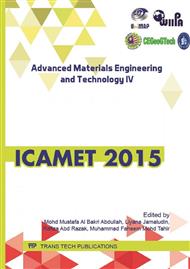[1]
H.C. Fu, M.A. Erki and M. Seckin: Review of effects of loading rates on concrete in compression. Journal of Structural Engineering Vol 117(12) (1991), pp.3645-3659.
DOI: 10.1061/(asce)0733-9445(1991)117:12(3645)
Google Scholar
[2]
CEB. Concrete structures under impact and impulsive loading. Bulletin No. 187, Comité Euro-International du Béton (CEB), Lausanne, Switzerland (1988).
Google Scholar
[3]
J.W. Tedesco and C.A. Ross: Strain-rate-dependent constitutive equations for concrete. ASME J Press Vessel Technol Vol 120 (1998), pp.398-405.
DOI: 10.1115/1.2842350
Google Scholar
[4]
T. Tang, L.E. Malvern and D.A. Jenkins: Rate effects in uniaxial dynamic compression of concrete. Journal of Engineering Mechanics Vol 118(1) (1992), pp.108-124.
DOI: 10.1061/(asce)0733-9399(1992)118:1(108)
Google Scholar
[5]
D.M. Cotsovos and M.N. Pavlovic: Numerical investigation of concrete subjected to compressive impact loading. Part 2: Parametric investigation of factors affecting behaviour at high loading rates. Computers & Structures Vol 86 (2008), pp.164-180.
DOI: 10.1016/j.compstruc.2007.05.015
Google Scholar
[6]
D.M. Cotsovos and M.N. Pavlovic. Numerical investigation of concrete subjected to high rates of uniaxial tensile loading. International Journal of Impact Engineering Vol 35 (2008), pp.319-335.
DOI: 10.1016/j.ijimpeng.2007.03.006
Google Scholar
[7]
P.H. Bischoff and S.H. Perry. Compressive behaviour of concrete at high strain rates. Materials and Structures Vol 24 (1991), pp.425-450.
DOI: 10.1007/bf02472016
Google Scholar
[8]
P.H. Bischoff and S.H. Perry. Impact behavior of plain concrete loaded in uniaxial compression. Journal of Engineering Mechanics Vol 121(6) (1995), pp.685-693.
DOI: 10.1061/(asce)0733-9399(1995)121:6(685)
Google Scholar
[9]
C.A. Ross, J.W. Tedesco and S.T. Kuennen. Effects of strain rate on concrete strength. ACI Materials Journal Vol 92: (1) (1995), pp.37-47.
Google Scholar
[10]
C.A. Ross, D.M. Jerome, J.W. Tedesco and Hughes ML. Moisture and strain rate effects on concrete strength. ACI Materials Journal Vol 93(3) (1996), pp.293-300.
Google Scholar
[11]
C.Y. Tan, R. Hamid and M. Kasmuri Dynamic stress-strain behaviour of steel fiber reinforced high-performance concrete with fly ash. Adv Civil Engg. Article ID 907431 (2012), pp.1-6.
DOI: 10.1155/2012/907431
Google Scholar
[12]
B. M. Hanumesh, B. K. Varun and B. A. Harish, The Mechanical Properties of Concrete Incorporating Silica Fume as Partial Replacement of Cement, International Journal of Emerging Technology and Advanced Engineering, Vol. 5 (9), (2015), pp.270-275.
Google Scholar
[13]
B. Riisgaard, T. Ngo, P. Mendis, C.T. Georgakis & H. Stang, Dynamic Increase Factors for High Performance Concrete in Compression using Split Hopkinson Pressure Bar . http: /orbit. dtu. dk/fedora/objects/orbit: 51275/datastreams/file_2899083/content, (2007).
Google Scholar


